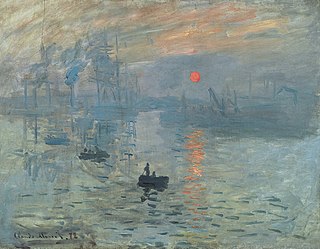
Impressionism was a 19th-century art movement characterized by relatively small, thin, yet visible brush strokes, open composition, emphasis on accurate depiction of light in its changing qualities, ordinary subject matter, unusual visual angles, and inclusion of movement as a crucial element of human perception and experience. Impressionism originated with a group of Paris-based artists whose independent exhibitions brought them to prominence during the 1870s and 1880s.

Mary Stevenson Cassatt was an American painter and printmaker. She was born in Allegheny, Pennsylvania, but lived much of her adult life in France, where she befriended Edgar Degas and exhibited with the Impressionists. Cassatt often created images of the social and private lives of women, with particular emphasis on the intimate bonds between mothers and children.

Edgar Degas was a French Impressionist artist famous for his pastel drawings and oil paintings.

American Impressionism was a style of painting related to European Impressionism and practiced by American artists in the United States from the mid-nineteenth century through the beginning of the twentieth. The style is characterized by loose brushwork and vivid colors with a wide array of subject matters but focusing on landscapes and upper-class domestic life.
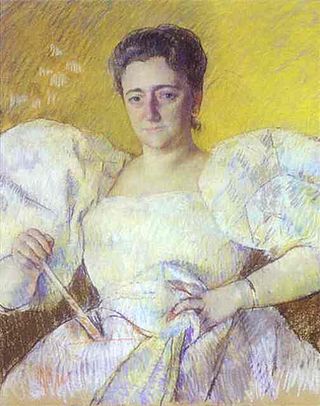
Louisine Waldron Elder Havemeyer was an art collector, feminist, and philanthropist. In addition to being a patron of impressionist art, she was one of the more prominent contributors to the suffrage movement in the United States. The impressionist painter Edgar Degas and feminist Alice Paul were among the renowned recipients of the benefactor's support.

The Child's Bath is an 1893 oil painting by American artist Mary Cassatt. The painting continues her interest in depicting bathing and motherhood, but it is distinct in its angle of vision. Both the subject matter and the overhead perspective were inspired by Japanese Woodcut prints and Edgar Degas.

Young Woman in Blue is a drawing by French artist Edgar Degas, created in 1884. It is currently in the permanent collection at the Indianapolis Museum of Art.

Mont Sainte-Victoire and the Viaduct of the Arc River Valley is an oil painting on canvas completed by the French artist Paul Cézanne between 1882 and 1885. It depicts Montagne Sainte-Victoire and the valley of the Arc River, with Cézanne's hometown of Aix-en-Provence in the background. Once owned by the art collectors and patrons Henry and Louisine Havemeyer, the painting was bequeathed to the Metropolitan Museum of Art in New York after the latter's death in 1929.
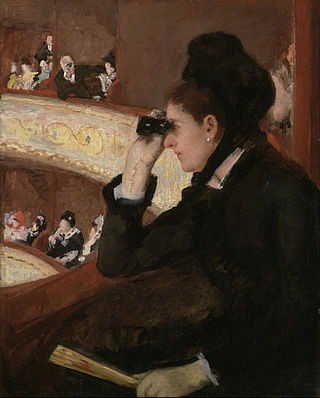
In The Loge, also known as At The Opera, is an 1878 Impressionist painting by the American artist Mary Cassatt. The oil-on-canvas painting is currently in the Museum of Fine Arts, Boston, which also holds a preliminary drawing for the work. The painting displays a bourgeois woman at the opera house looking through her opera glasses, while a man in the background looks at her. The woman's costume and fan make clear her upper class status. Art historians see the painting as commentary on the role of gender, looking, and power in the social spaces of the nineteenth century.

Little Girl in a Blue Armchair is an 1878 oil painting by the American painter, printmaker, pastelist, and connoisseur Mary Cassatt. It is in the collection of the National Gallery of Art, Washington D.C. Edgar Degas made some changes in the painting.

Gardner (Cassatt) Held by His Mother is a drypoint print dated circa 1889 by the American painter, printmaker, pastelist, and connoisseur Mary Cassatt. The example illustrated is in the collection of the Cooper-Hewitt Museum and is a gift of Samuel Putnam Avery.
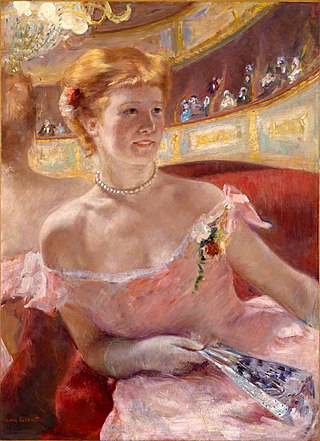
Woman with a Pearl Necklace in a Loge is an 1879 painting by American artist Mary Cassatt. The Philadelphia Museum of Art acquired the painting in 1978 from the bequest of Charlotte Dorrance Wright. The style in which it was painted and the depiction of shifting light and color was influenced by Impressionism. This painting shows a view of the modern woman and is similar in style to Degas.

The Boating Party is an 1893 oil painting by American artist Mary Cassatt. It has been in the collection of the National Gallery of Art since 1963.

Young Mother Sewing aka Little Girl Leaning on her Mother's Knee is a 1900 painting by Mary Cassatt. It is in the collection of the Metropolitan Museum of Art.

Lydia Crocheting in the Garden at Marly is an oil-on-canvas painting by Mary Cassatt created in 1880. It is in the collection of the Metropolitan Museum of Art.
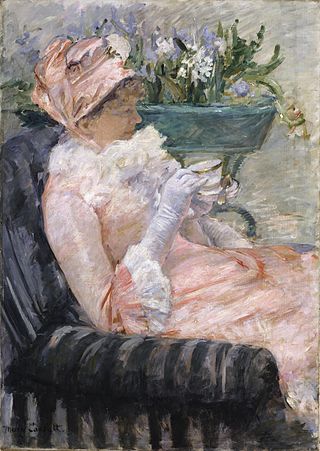
The American artist Mary Cassatt painted The Cup of Tea in Paris ca. 1879–1881. The painting depicts Mary’s sister Lydia Cassatt in a typical, upper class-Parisian ritual of afternoon tea. Scholars have observed that Cassatt’s choice to employ vivid colors, loose brushstrokes, and unique perspective to portray the scene makes it a quintessentially Impressionist painting.

Lady at the Tea Table is a late 19th-century painting by American artist Mary Cassatt. The work, done in oil on canvas, is in the collection of the Metropolitan Museum of Art.

Woman with a Sunflower is a 1905 oil painting by the American artist Mary Cassatt. It has been in the collection of the National Gallery of Art in Washington, DC since 1963.

The Tea, also referred to as Five O’Clock Tea, is an oil-on-canvas painting of two women having tea by the American Impressionist painter Mary Cassatt. The role of gender in the painting has been the subject of differing interpretations among art historians. Griselda Pollock describes the confined interior as an evocation of the spatial and social constraints placed on women at the time. Norma Broude asks whether the work might contain "possibilities for empowerment," showing the agency that women exercised through sociability. And John Loughery argues that the intention behind Cassatt's work might always remain a mystery.





















